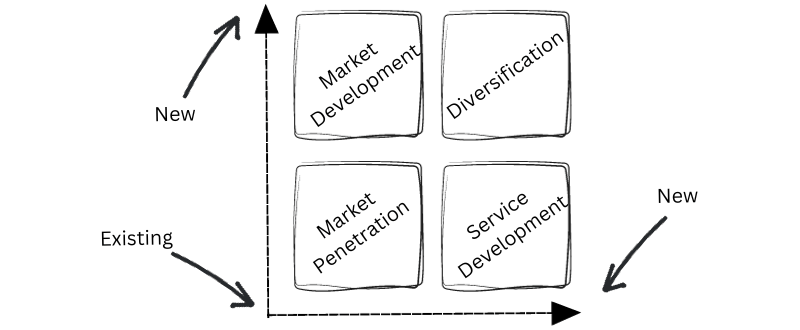OKR Framework: The Ultimate Guide To Goal-Setting For Professional Services Firms
-
Nga Nguyen
- Last updated:

Setting goals, whether for personal or business, can be deceptively tricky. Do a quick search and you’ll find several approaches to goal-setting, but one that has always stood out for me is the OKR framework (Objectives and Key Results).
If you work in tech, chances are you’ve heard of the OKR framework – it’s just not widely known outside of tech. In this post, I’ll break down how to effectively set and manage goals using OKRs, the right way. While throughout this post I’ve used examples focused on legal services, the overarching principles of the OKR framework can be equally adapted to other professions, such as accounting, insurance broking, etc.
Quick history on the OKR Framework
Originated by Intel, the framework gained popularity and was later adopted by several high-profile tech companies such as Google, Netflix, and Adobe in the late 90s. The framework hit prime time when John Doerr (a prominent VC and early backer of Google) played a significant role in evangelizing OKRs to other organizations through his book “Measure What Matters,” published in 2017.
Why OKRs? And what problems do they solve?
Teams not marching in the same direction
As teams grow in size and complexity, inevitably there will be a wider diversity of perspectives, priorities, and approaches. Communication breakdowns and silos often emerge. Different team members interpret goals differently or have conflicting priorities. Without a shared understanding of the firm’s overarching objectives, individual team members tend to push their own agendas.
Accountability gap between strategy and execution
The OKR framework provides a clear link between strategy and execution. It ensures that the strategic objectives set by the firm are translated into actionable goals that can be tracked and measured.
How the OKR framework works

Let’s now dive into the 3 components of the framework.
OKR component #1 - Objectives
Objectives are the big picture goals you want to achieve within a certain timeframe. Think of them as destination pins on a map. Objectives give you a clear sense of direction and purpose, guiding your efforts and activities. It’s best to keep objectives as high-level statements, qualitative, and even aspirational in nature. It’s not necessary to assign metrics to objectives – that’s what the Key Results are for.
Top tips:
👉 Be ambitious: Objectives should be ambitious (stretched goals) that challenge both you and your team to push beyond your comfort zone. That said, they should also be manageable and attainable – this, of course, is a delicate balance.
👉 Align with business goals: Objectives should align with the overall goals and mission of your firm. They should contribute to the larger strategic direction and priorities.
👉 Limit to 5: The ideal number of objectives can vary depending on the firm and the specific context, but as a rule of thumb, it’s best to keep it between 3 and 5. Having too many objectives can lead to a dilution of focus.
Among the three components of OKR, defining the right objectives is perhaps the most critical. I’ll provide more details on how to define objectives in the OKR planning process section.
OKR component #2 - Key results
Key results are like checkpoints along the way – they answer the question: ‘Are you on the right path towards achieving your objectives?’. They should be measurable and time-bound.
Top tips:
👉 Focus on outcomes: Key results should focus on outcomes rather than outputs. Instead of measuring activities or tasks, focus on the impact or results that you want to achieve. At the risk of sounding controversial, a classic example of focusing on outcomes rather than outputs for a law firm could be shifting the focus from measuring the number of hours worked by lawyers (output) to measuring the client’s satisfaction with the legal services provided (outcome). I’ll leave the topic on why the billable hour is broken for another post 😀.
👉 Align with objectives: Key results should align with the overall objectives of the OKRs. They should directly contribute to the achievement of the objectives and reflect the desired outcomes.
👉 Both quantitative & qualitative: Unlike objectives, key results should include both quantitative (numerical data that’s reasonably easy to capture) and qualitative metrics.
OKR component #3 - Initiatives
Initiatives are like action plans that you undertake to achieve your Key Results (and ultimately your Objectives). Although not traditionally part of the OKR framework, initiatives are a great way to break down your goals into manageable tasks. They outline the specific actions, activities, or strategies that you need to implement to reach your Key Results and make progress towards your overall Objectives. Think of initiatives as mini internal projects.
Top tips:
👉 Be specific and actionable: Initiatives should outline clear and concrete actions or steps that need to be taken to achieve the key results. They should be specific and actionable, providing a clear roadmap for implementation.
👉 Align with key results: Initiatives should directly support the achievement of the key results. They should align with the metrics and targets set for each key result.
👉 Assign ownership: Someone should always be on the hook for its delivery. Each initiative should have an owner or accountable person who will be responsible for driving its implementation (and success).
Win & retain more clients with Portalstack
14-day free trial. No credit card required.
Example OKRs
Example OKR #1
Scenario: Clients consistently provide negative feedback about the responsiveness of the firm’s lawyers.
Objective: Improve client satisfaction
🎯 Key Result 1: Increase client satisfaction survey rating by 10%
🎯 Key Result 2: Maintain a client retention rate of at least 85%
🎯 Key Result 3: Achieve a Net Promoter Score (NPS) of 8 or higher
Example initiatives:
📍 Implement a solution to streamline the client onboarding experience.
📍 Implement a simple client portal to securely exchange sensitive files without the need for back-and-forth emails.
📍 Conduct customer journey workshops with top clients.
Example OKR #2
Scenario: The firm is facing challenges in managing their caseload effectively.
Objective: Enhance operational efficiency
🎯 Key Result 1: Reduce average case resolution time by 20%
🎯 Key Result 2: Streamline document management process to reduce errors by 15%
🎯 Key Result 3: Improve workflow and process efficiency by reducing the number of manual tasks by 20%
Example initiatives:
📍 Conduct a review of core operational processes to identify if any processes can be automated or streamlined.
📍 Conduct a review to weigh up the pros and cons of outsourcing certain admin tasks to external service providers.
Example OKR #3
Scenario: The firm wants to grow its business and increase its revenue by generating more business opportunities, diversifying its client base and practice areas, thereby reducing dependency on a limited number of clients.
Objective: Expand client base
🎯 Key Result 1: Increase number of new client referrals by 20%
🎯 Key Result 2: Develop and execute a marketing campaign to generate 15% more leads
🎯 Key Result 3: Secure partnerships with at least two local businesses for client referrals
Example initiatives:
📍 Establish partnerships or referral programs with complementary businesses or professional services firms to generate client referrals.
📍 Offer educational webinars or workshops on legal topics relevant to the target audience to attract potential clients.
📍 Develop case studies or success stories showcasing the firm’s expertise and successful outcomes.
Example OKR #4
Scenario: The firm wants to prioritize the growth and improvement of their legal team to ensure that their lawyers and associates are continuously developing their skills and knowledge.
Objective: Enhance professional development
🎯 Key Result 1: Provide training to all associates on a new practice area
🎯 Key Result 2: Have each attorney attend at least one industry conference or seminar
🎯 Key Result 3: Implement a system to track the continuous learning hours of each lawyer and aim for an increase of 10% in the next quarter
Example initiatives:
📍Create a mentorship program to pair junior associates with experienced lawyers, fostering their professional growth and providing guidance.
📍 Implement regular ‘lunch and learn’ sessions on emerging legal topics (such as AI) or practice areas.
Example OKR #5
Scenario: The firm has been experiencing high turnover rates among its legal staff due to increased competition for legal talent and lack of employee engagement or satisfaction.
Objective: Enhance lawyer retention
🎯 Key Result 1: Increase lawyer retention rate by 10% within the next year
🎯 Key Result 2: Conduct regular employee satisfaction surveys and maintain a rating of at least 80%.
🎯 Key Result 3: Improve work-life balance for lawyers, resulting in a 15% decrease in voluntary resignations.
Example initiatives:
📍 Create a career development plan for each lawyer, including opportunities for training, skill enhancement, and advancement within the firm.
📍 Establish a recognition and rewards program to acknowledge contributions and achievements.
📍 Improve work-life balance by implementing flexible work arrangements, such as remote work options or flexible hours.
The OKR planning process

#1 - Agree on the OKR planning cycle
Determine the timeframe for the OKR cycle. While it’s common to set OKRs on a quarterly basis, there’s no hard and fast rule around this. It’s best to just agree on a cycle and stick with it.
#2 - Define or revisit your vision
It might sound tempting to just jump straight into defining your objectives, but your objectives should be derived in the context of your higher-level business strategy. Defining your business vision and mission first provides the foundation for setting objectives that ultimately align with your long-term goals and values. Your vision and mission serve as your ‘North Stars’ that shape the direction and purpose of your firm. Your objectives should then be a reflection of the larger strategic direction you have established.
#3 - Define your strategic priorities
Next step is to take a moment to zoom out and assess where you’re at in terms of your own initiatives as well as the broader marketplace and macro environment. Establishing strategic priorities is vital, as it determines which areas of the firm need the most attention and develop a roadmap for achieving your objectives. It also ensures that resources are allocated effectively and that everyone is working towards the same strategic goals – i.e. everyone is marching in the same direction.
To help guide your thinking and discussions and to surface your priorities, here are some popular mental models you can employ:
SWOT Analysis:
SWOT (Strengths, Weaknesses, Opportunities, and Threats). It involves assessing internal strengths and weaknesses, as well as external opportunities and threats, to identify strategic priorities based on the firm’s current position and the market landscape.
Balanced Scorecard:
The balanced scorecard is a framework that looks at the business from four different perspectives: financial, customer, internal processes, and learning and growth. It helps identify strategic priorities by considering various aspects of the business and ensuring a balanced approach to goal-setting.
Ansoff Matrix:
The Ansoff Matrix is a framework that helps identify growth strategies by considering existing and new services and existing and new markets. It provides a framework for selecting the most suitable strategic priorities based on the firm’s growth objectives.

#4 - Define business level OKRs
Now it’s time to create your business-level OKRs. Assuming you’ve already spent some time determining your north star vision and strategic priorities, the process of identifying your top business-level OKRs should be relatively quick. Follow the steps mentioned earlier to define your Objectives, Key Results, and Initiatives. And remember, it’s generally best practice to limit the number of objectives to 5 to avoid diluting focus.
#5 - Cascade down your business level OKRs

To ensure that everyone in the business is working towards the same goals, it’s important to cascade the business-level OKRs down to individual and team levels. This alignment promotes transparency and accountability. This step assumes, of course, that you have a team and does not apply to solo firm owners.
#6 - Monitor and review progress
Make sure to keep an eye on your key results regularly. It’s important to take a step back, see how things are going, and make changes if needed. This isn’t a one-and-done type of activity – you should be checking in and tweaking things as you go. It’s all about learning, improving, and adapting.
#7 - Celebrate milestones and achievements
Don’t forget to give a big shout-out for all those small wins and big leaps along the way. Applaud the strides everyone’s making towards those key results and all their hard work. It keeps the spirit high and keeps everyone pumped.
#8 - Conduct a retrospective
Once you’ve wrapped up the planning period, it’s a good idea to kick back and review your OKR journey. Did everything go smoothly, or were there some bumps along the road? Round up what you’ve learned and jot down any feedback that could help make the next cycle smoother. Use this chance to polish up your OKR planning process and tweak anything that needs some fine-tuning.
Wrap up
The OKR framework provides a structured and transparent approach to goal-setting, aligning teams and promoting accountability. The framework promotes:
Alignment and focus:
Everyone in the firm is working toward common goals. This alignment helps teams prioritize their efforts and stay focused on what matters (i.e., the stuff that really moves the needle).
Transparency and accountability:

Everyone’s goals are out in the open for the whole team to see. This means you can see exactly how your work fits into the big picture. And let’s face it, who doesn’t love feeling like they’re part of something bigger? Plus, this visibility means we can all celebrate each other’s progress and wins. And if things aren’t going quite as planned, regular check-ins give us a chance to chat about it and make tweaks where needed.
Effective goal-setting:
Traditional goal-setting often focuses on outputs or activities instead of outcomes. This can lead to lack of motivation and disconnect between individual efforts and firm goals. The OKR framework solves this problem by emphasizing measurable key results and inspiring teams to set stretched goals.
Securely collect customer data & documents 10x faster with Portalstack
14-day free trial. No credit card required.
Share this article
© Portalstack 2024. All rights reserved.
Privacy Policy | Terms of Service | Security Policy
Made with in Melbourne